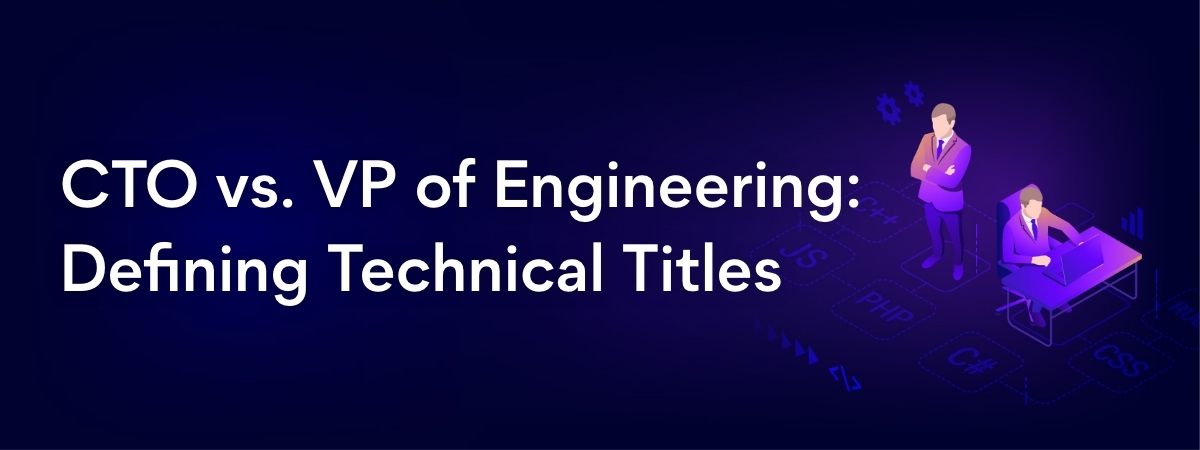In the dynamic world of technology, leadership positions often have intricate and different roles and responsibilities that significantly impact a company’s growth and success. Two roles that sometimes need clarification are Chief Technology Officer (CTO) and Vice President of Engineering (VPE). While both roles involve core competencies related to technology infrastructure and software development, they each have distinct functions contributing to a company’s technological advancement and operational efficiency.

Who is a CTO?
A Chief Technology Officer (CTO), often referred to as a technology visionary, plays a pivotal role that holds the highest position in the technology leadership position. The CTO is not only responsible for formulating and executing strategies to enhance products and services with technology but also for conducting critical technical due diligence. They also oversee the needs of research and R&D activities. They focus their efforts on aligning the company’s products and technologies with the customer needs.
Becoming a Chief Technology Officer (CTO) requires a unique blend of technical knowledge, industry insights, and leadership abilities. Individuals who hold this position have usually devoted over 15 years of their professional lives to the IT industry and possess an advanced degree in computer science and business administration certifications.
A CTO role demands a deep understanding of technology and the ability to align technology strategies with overall business objectives. Although this position comes with its fair share of challenges, it can be incredibly satisfying for those with what it takes. Navigating the ever-evolving tech landscape and leading development teams toward success is both a responsibility and an opportunity for them.
Responsibilities of a CTO
The depth of responsibilities that a CTO has can vary based on the company’s size, industry, and goals. However, in general, here are the primary responsibilities:
Strategic planning
The CTO formulates the vision for the technology in the company. This includes defining goals and timelines and aligning these strategic initiatives with the business objectives. They oversee the existing system infrastructure to maintain efficiency.
Innovating and research
The CTO has to consistently keep up with the emerging tech stack, technology advancements, and industry trends; they identify and implement these innovative technologies that give the company a competitive edge in today’s market.
Technology management
The CTO manages the existing technologies and solutions to ensure that the resources can fulfill short-term and long-term goals. They monitor the Key Performance Indicators (KPIs) and IT budgets to assess the technological budgets.
Team Management
The number of team members the CTO manages can vary depending on the company size. But ideally, a CTA manages the engineering team’s technical architects, and tech leads and plays a crucial role in people management. They also mentor team members and guide as needed.
Business Alignment
The CTO works in tandem with other executives to develop budgets for implementing new technology and solutions. They are responsible for assessing the company’s overall direction and goals to understand how technology fits into business decisions. They collaborate with key stakeholders and adapt technology based on feedback.
Client focus
The CTO is involved in developing and overseeing the technology solutions for clients. They make sure the services are on par with the customer’s expectations.
Technical processes
The CTO oversees and optimizes technical processes in the organization. This includes identifying inefficiencies, implementing best practices, and ensuring that technology-related workflows are streamlined for maximum efficiency.
Closely works with product managers
CTOs play a vital role in product management. They work closely with product managers and development teams to align technology strategies with product roadmaps. It involves defining product features, setting technical requirements, and assuring the technology stack supports the product’s objectives.
Who is a VPE?
VP engineering role involves overseeing and managing the engineering organization. The VPE ensures the success of the engineering department by leading the team of engineers and engineering managers to build and develop quality software. This directly contributes to the company’s technical roadmap. The VPE is also a key link between the technical teams and the company’s goals.
They also play a crucial role in software engineering leadership. VPEs typically have a background in engineering or a related field, possess strong leadership skills, and have extensive experience in software development and management. VP engineering role is critical in driving engineering teams’ success and contributing to the company’s technological advancement.
Responsibilities of a VPE
To translate the roadmap into technical advancement, here are the responsibilities of a VPE:
Leadership Management
The VPE mentors and leads the development teams, engineers, and engineering managers. They take part in recruiting, developing, and managing the technical teams.
Strategy planning
The VPE collaborates with the company’s other executives to shape and align the technical strategy with the business goals. They create a roadmap for the company’s vision. ‘
Quality assurance
VPEs have a crucial responsibility of ensuring that quality standards are met consistently. They develop the standards, procedures, and best practices to provide high-quality software development.
A VPE’s challenge is finding the balance between speed and quality in software development. They work with their teams to optimize engineering processes and ensure timely delivery of quality products.
Budgeting
The VPE is responsible for preparing and optimizing the engineering department’s budgets. They also help optimize processes by recommending technological improvements to increase efficiency.
Technology trends
A VPE needs to stay informed about industry trends to recommend technological advancements for the company’s benefit.
KPI monitoring
Have to monitor KPIs related to engineering performance and ensure the delivery of the roles. The VPE assesses and addresses any obstacles that impact KPI achievement.
Company vision
The VPE ensures the company’s vision is translated into business value through the technical roadmap. They have consistently ensured the engineering team’s objectives align with the company’s objectives.
Effective communication
They have to collaborate with cross-functional teams like product managers, designers, business, marketing, sales, and more to bring cohesive collaboration and effective communication.
Reporting
The VPE reports to the CTO, the board, and the other stakeholders regarding the engineering organization. They communicate the areas where engineering needs support and help set them up for success.
Culture building
VPEs are responsible for building the culture of the engineering teams – this includes -fostering a healthy work culture that enables psychological safety and inclusivity for all. Such culture-building principles ensure employee satisfaction and retention.
The VPE role is distinct from the Chief Technology Officer (CTO), with the VPE often focusing on operational and management aspects. At the same time, the CTO is more focused on the company’s overall technical strategy.
The equation between a CTO and VPE - Differentiating factors
It’s important to differentiate between the roles of VPE and CTO in a company. The VPE handles operational management and execution, while the CTO focuses on the overall technical strategy. The CTO also manages the company’s patent portfolio and works closely with the VP of Engineering to develop effective patent strategies. They may also represent the company through media appearances and conferences.
Here are the differentiating factors:
Vision and Strategy:
- A CTO focuses on technical direction and thought leadership and ensures it is aligned with company goals
- A VPE focuses on the execution of the product vision through effective technical leadership
Supervision:
- A CTO leads smaller groups of engineering managers, architects, and research engineers
- A VPE supervises the technical staff and engineering teams directly
Responsibility and planning:
- The CTO steers the company’s technological direction, engineering culture, and vision
- A VPE builds and retains developer teams, charts progress, and contributes to employee growth
Specialization and Execution:
- The CTO focuses on overall leadership, research, revisiting processes, and examining tech architecture
- The VPE specializes in people, processes, and program management
Collaboration:
- The CTO is the technological leader, often involved in customer-facing activities and working closely with the CEO
- The VPE collaborates internally with engineers and management to develop company strategies and product
How to choose the right role between a CTO and A VPE?
When considering potential job roles, evaluating your strengths and aspirations is imperative. Assess your areas of expertise and determine which position would best align with your skills.
For those seeking new opportunities or hiring for leadership positions, it’s beneficial to focus on the role’s responsibilities rather than just the job title. Consider the areas where your company needs improvement and seek individuals to assist with those specific challenges.
It’s crucial to comprehend the distinctions between the roles of a CTO and a VPE. Although both positions contribute to a company’s technological advancement, the CTO is responsible for driving innovation and technical vision, while the VPE ensures operational efficiency and execution. By understanding these roles clearly, individuals and organizations can make informed decisions that will ultimately lead to growth and success.





